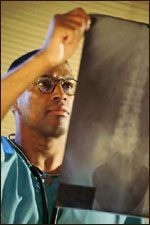Diagnostic Exams
There are a variety of diagnostic exams that may be used to determine the cause of your back and/or neck pain, as well as the type of treatment that may be appropriate for you. Your doctor may recommend one or more of the following
X-ray

An x-ray is a painless, non-invasive imaging process that utilizes photographic film to absorb electromagnetic radiation transmitted through a material body. These images, also known as radiographs or roentgenograms, are used to diagnose and monitor the treatment of various disorders. Forward and backward bending x-rays may help your doctor assess potential instability. Read more
CAT/CT Scan
A CAT (computed axial tomography) scan, also known as a CT (computed tomography) scan, is a painless imaging technique that utilizes a computer to produce detailed three-dimensional images of a body from a collation of cross-sectional x-rays taken along an axis. Of all the imaging techniques that are currently available, the CAT scan is best able to produce images of bone and metal devices. Read more
MRI
MRI stands for magnetic resonance imaging. It is a non-invasive technique for imaging the spine that involves rotating a magnet around the body and exciting its hydrogen atoms. A scanner is then utilized to detect the energy emitted by the excited atoms. Because the human body is composed primarily of water, which is two parts hydrogen, an MRI provides exceptional detail of the spine’s anatomy and is the single most useful test available for diagnosing spinal disorders. Read more
Myelogram
A myelogram involves injecting a radiographic contrast dye into the sac (dura) surrounding the spinal cord and nerves, and then taking x-rays of the spine. This allows the radiologist to specifically x-ray the nerve roots. Any abnormalities within the spinal canal can potentially be identified to aid in the diagnosis of certain spinal problems, such as nerve compression or a disc rupture. Read more
Discogram
A discogram can determine whether a spinal disc is the cause of back or radicular pain. Using a fluoroscope for guidance, the doctor inserts a spinal needle into the disc and injects radiopaque dye into the nucleus (center) of the disc. In a healthy disc, the dye will remain contained within the central nucleus. If the dye leaks out of the nucleus into the surrounding tissue, the disc is considered abnormal if concordant symptoms during the injections replicate the complaints usually noticed by the patient. Read more
Bone Scan
A bone scan involves intravenously injecting a small quantity of a radiographic marker into the patient and then running a scanner over the area of concern. The scanner detects the marker, which concentrates in any region exhibiting high bone turnover. A bone scan is utilized when there is suspicion of tumor, infection or small fractures, i.e., conditions that all result in high bone turnover. A bone scan does not replace the above tests, but may provide additional information by eliminating other serious problems. Read more
DEXA Scan
A DEXA (Dual Energy X-ray Absorptiometry) scan measures bone mineral density to check for possible bone loss. During the test, the patient lies fully clothed on a padded table while the DEXA scanner beams x-rays from two sources towards the bone being examined (usually the lower spine or hip). A radiation detector device is slowly passed over the examination area, producing images that are projected onto a monitor. A computer then analyzes the images and calculates bone density based on the amount of radiation absorbed by the bone (the denser the bone, the more radiation it absorbs).
The test, which may take up to 30 minutes, is performed by a physician or technician and requires no injections, sedation, special diet or any other advance preparation. Read more
 Menu
Menu









